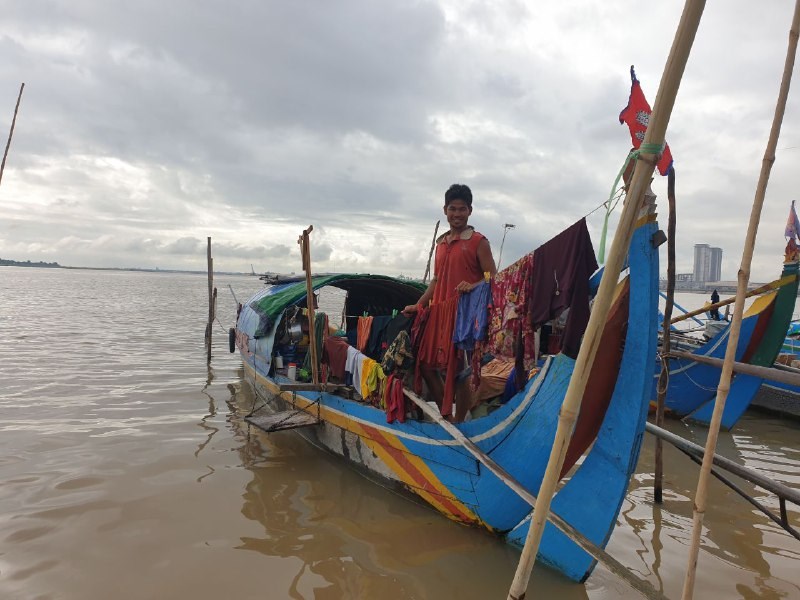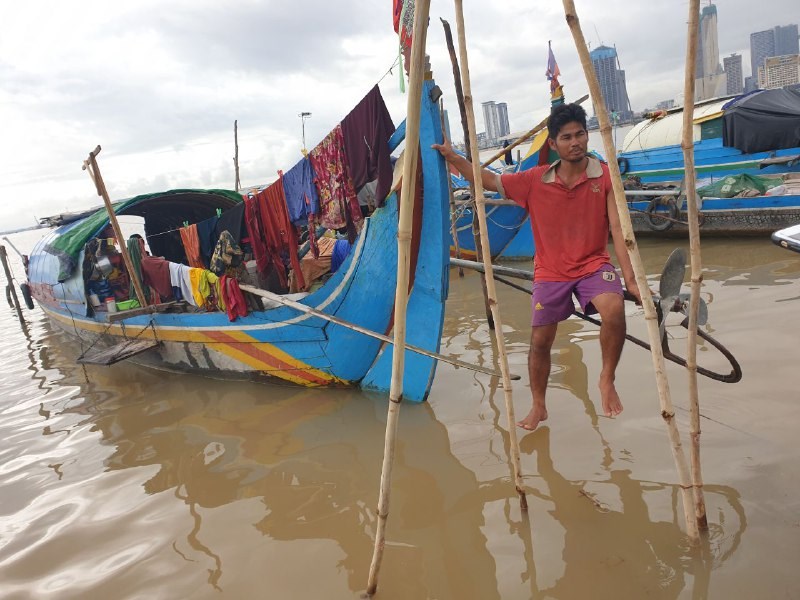Did Cambodia’s Most Famous River Stop Changing Course?
October 16, 2020Not far from Cambodia's famed Angkor Wat temples, the towering stilts keeping wooden houses at safe levels above water have been rendered useless — the land below is dry.
It's September, the height of rainy season, and these floating villages on the upper edge of the Tonle Sap lake should be flooded. But something has gone wrong. The eponymous river that pushes billions of gallons of water into the lake each rainy season has gone still. The lake, which expands and contracts like a beating heart twice each year for millennia has barely spilled past its dry season borders.
"We don’t see the water rising up like before," said Kheav Cheam, a 50-year-old fisherman. "In the past, the water rose higher and spilled into the lake, so we could catch fish. But now, the water doesn't go into the lake and the fish don't grow bigger."
In Cambodia, fish is the main source of protein for as much as 80 percent of the population. Cheam, who lives with his family in a small boat that they move between the river and the lake, has survived off these waters his entire adult life. Now, he often fails to catch enough to offset the cost of gasoline. "We're afraid that people living in the upper parts have closed the dam, so we are growing desperate. It's getting worse and worse for fishing — in the future, there will be no fishing, because there is no water left."
The Tonle Sap lake is the largest body of freshwater in all of Southeast Asia and one of the most successful inland fisheries in the world. Its productivity comes from a unique hydrological function. The lake is fed by the Tonle Sap river, a Mekong tributary that reverses course twice a year, sending water, nutrients, and migrating fish down from the upper reaches of Asia's mighty Mekong river into the lake and back again. The first reversal typically takes place in May, as the Mekong swells with rain, forcing water into the Tonle Sap river and up into the lake. By November, the volume of the lake has grown so large it exerts an opposite force, sending water back down the eponymous river and into the Mekong.
This flood pulse that feeds Cambodia's Tonle Sap can expand the lake up to six times its size — as much as 6,000 square miles — during the rainy season. With it comes fish, an extraordinary abundance that has sustained the population for thousands of years. Ancient lakeside tombs hold the remains of cooked meals: fish salted and marinated; fish turned into soup; fish roasted and smoked. Angkorian bas reliefs are studded with snakeheads and carps and vendors selling freshly caught fish. "There are very many fish whose names I don’t know, all of them coming from the Freshwater Sea ... They get clams, mud clams and pond snails just by scooping them out of the Freshwater Sea," Zhou Daguan, a Chinese emissary who penned the first outsider's account of Cambodia, wrote in the late 13th century. Today, some 500,000 tons of fish are pulled from the lake each year, and millions more from the rest of the lower Mekong basin, which spreads across neighboring Thailand, Laos, and Vietnam. With the flood pulse slowing, the fish are fast vanishing.

Last year, the Tonle Sap river reversal occurred months later than usual and lasted barely six weeks. This year, some believe it never reversed course at all. If it did, climate change and dams have left the river level so low as to make the reversal negligible.
Usually, the reversal lasts 160 days and sends 38.37 cubic-kilometers of water flooding into the lake, according to two-decade averages collected by the Mekong River Commission, an intergovernmental body aimed at joint river management. An MRC report released at the end of September shows a staggering drop. During July, August, and September, the lake reached a quarter of its normal volume. In fact, the lake's volume during that time was barely half of what it was a year earlier — when the Mekong receded to a historic low, leading to food shortages across the region.
"We don’t know what's wrong with the water," said Im Kim Rai, a 33-year-old fisherman whose catch has fallen dramatically. "I have never seen the water this low."
Kim Rai lives on the Mekong river in Kampong Cham, about 30 miles upriver from Phnom Penh. The catch in the Mekong had been abysmal, its level through much of September far lower than it had been even last year, and so Kim Rai, his wife, and five-year old traveled down the Mekong to where it meets the Tonle Sap river in the hopes of a better haul. In the few days since they had arrived in Phnom Penh, however: "We have gone out to fish nearly 10 times but we could not catch anything."

Monitoring from the Mekong River Commission shows that water levels on the Tonle Sap river in September were about half their average depth. At the end of September, the river approaches its maximum height: it's typically some 8.5 meters deep at Phnom Penh Port, which sits at the bottom of the Tonle Sap river, less than a mile from where it meets the Mekong. This year, it was 4.4 meters.
Until mid-October, as a tropical storm and flash flooding battered Cambodia, the height of the Tonle Sap river never once topped 5 meters — a depth, that if sustained, serves as the tipping point at which the river would reverse course, according to Brian Eyler, Southeast Asia program director at the Stimson Center.
"The Mekong could receive more storms this rainy season, but they will be quick pulses which will likely subside quickly. I don't hold much hope for the Tonle Sap expansion this year," explained Eyler, a Mekong river expert who has been tracking Tonle Sap levels via satellite and sounded the alarm on this year's vanished reversal.
The Mekong River Commission says the river did reverse course — on Aug. 4. But the water level is so low, and the volume of water flooding into the lake is so scant, it might not have done so at all. "The flow of the Mekong to the Tonle Sap is still reversing, but it's very small — that's why I say it's at a very, very critical situation," Sopheak Meas, a communications officer at the Mekong River Commission Secretariat, said in early October.
With the rapid expansion of hydropower dams along the Mekong and its tributaries, the Tonle Sap lake has been doomed for years now, but the pace at which it is dying has taken fishers by surprise. Over just two decades, the average level of the Tonle Sap river has dropped by about two meters. The last five years have been the five warmest on record, and repeated El Nino weather conditions have led to multiple, devastating droughts in Southeast Asia. Any chance of the lake's recovery from the changing climate has been obliterated by the influx of dams on the mainstem and tributaries of the 2,700-mile-long Mekong — which runs from China, through Myanmar, Thailand, Laos, and Cambodia before releasing into Vietnam's delta.
Since the 1990s, a flurry of hydropower dams have been built on the Mekong and its tributaries. Eleven dams are operational on the mainstem of the Lancang, or upper Mekong river in China, and two on the lower Mekong, in Laos — with more than a dozen additional dams in the works. There are more than 100 dams on the tributaries, and another 400 planned. Those dams have rapidly choked off the downstream flow. In order for the Tonle Sap river to reverse, the amount of water in the Mekong has to reach a sufficient volume. Last year, the Mekong hit its lowest levels ever. This year, it's barely any higher.
"The Tonle Sap has gone through difficult droughts before. The system is adaptive and fisheries could recover. But the dams are a killer for migratory pathways and deliver permanent regulatory effects to the Tonle Sap expansion during both the dry season and the wet season," said Eyler.
Researchers have long warned of the dams' dangers to the ecosystem of the Mekong river basin. They block migratory pathways, and prevent nutrient-rich sediment from reaching the floodplains. Security analysts, meanwhile, have long warned of the dangers inherent in having a single upstream nation control the flow of one of the longest rivers in the world. That appears to have been borne out. Research from Eyes and Earth shows that last year, while the lower Mekong basin suffered its worst drought in a century, China held back an unprecedented amount of water — effectively starving its downstream neighbors of their river. China disputed the research, saying they sought to discharge sufficient water and suffered their own low rainfall. But the findings are stark, particularly as China seeks to expand its role as a Mekong region leader. "If China's dams did not restrict flow, portions of the Mekong along the Thai-Lao border would have experienced above average flows from April 2019 to the present instead of suffering through severe drought conditions," notes a report from the Stimson Center.
As fishers in Cambodia contend with a second, critically low year, the desperation is palpable. Many count among the country's poorest, with no land to their name and extremely high levels of debt due to the increasingly unpredictable livelihood. "We don’t know what to do when they have closed the dam in the upper part,” said Kheav Cheam. "The only way is for our government to request the other countries to release the water. We are people, but we have no rights."
Additional reporting by Mech Dara
Follow Abby on Twitter
